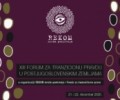Racist Positions of the Court of Appeals in the Judgment in the Skočić Case
 The War Crimes Department of the Court of Appeals in Belgrade (Court of Appeals Department) has quashed the judgment rendered by the Higher Court in the Belgrade War Crimes Department (Higher Court Department), by which seven members of “Simo’s Chetnicks”, a paramilitary unit, were found guilty of committing war crime in the village of Skočić (in the Municipality of Zvornik, B&H), and sent the case back for a new trial. The Humanitarian Law Center (HLC) holds that the judgment rendered by the Court of Appeals contains a number of controversial findings, and that the rationale based on racist positions are particularly unacceptable and utterly inappropriate for a court, as well as being highly offensive to the victims.
The War Crimes Department of the Court of Appeals in Belgrade (Court of Appeals Department) has quashed the judgment rendered by the Higher Court in the Belgrade War Crimes Department (Higher Court Department), by which seven members of “Simo’s Chetnicks”, a paramilitary unit, were found guilty of committing war crime in the village of Skočić (in the Municipality of Zvornik, B&H), and sent the case back for a new trial. The Humanitarian Law Center (HLC) holds that the judgment rendered by the Court of Appeals contains a number of controversial findings, and that the rationale based on racist positions are particularly unacceptable and utterly inappropriate for a court, as well as being highly offensive to the victims.
According to the first instance judgment, members of the “Simo’s Chetnicks” unit entered the village of Skočić on July 12th, 1992. They gathered all the Roma citizens in the village at that moment into one house and beat them; they stole all of their valuables and raped three girls (who participated in the trial under the pseudonyms “Alpha”, “Beta” and “Gamma”). Then they took all of them by truck to a place called Malešić, where they separated the injured parties “Alpha”, “Beta” and “Gama”, and placed them into the houses they resided in, while they took the remaining 27 Roma to a place called Hamzići, where they killed them and threw them inside a pit. The oldest victim was 71 years old, while the youngest was only two years old. The injured parties “Alpha”, “Beta”, and “Gamma”, who were 13, 15, and 19 years old at the time, were coerced into staying with the unit to prepare food for the soldiers, wash their clothes and clean the houses in which they resided, under orders to do anything that any member of the unit asked them to do or be killed. The injured parties were raped and sexually humiliated on a number of occasions.
The following persons were found guilty of this crime in the first instance judgment: Damir Bogdanović, Zoran Alić, Đorđe Šević, Dragana Đekić, Tomislav Gavrić, Zoran Đurđević and Zoran Stojanović. They were sentenced to a total of 72 years of imprisonment.
The accused Dragana Đekić was found guilty in the first instance judgment of, among other things, stealing gold earrings and pendants in the shape of a cross and a horseshoe, as well as a gold ring, from the injured party “Gamma” (15-years-old at the time). While searching the victim, she asked her, “What do you need a cross for?”
The Court of Appeals Department judgment (page 13 of the judgment) inappropriately doubted the responsibility of the accused Đekić for the act of robbery. The court stated that “the Defence Counsel of the accused Đekić in the appeal justifiably pointed to the fact that the first instance court failed to give clear reasons for the ‘emotional connection’ of the injured party and the jewellery in question, nor did it attempt to establish the origin of the jewellery on the injured party, despite the fact that a Serb village nearby had been massacred at that time” [edited by HLC]. According to this reasoning, the Court of Appeals suggests that the jewelry taken from “Gamma” may have originated with the allegedly massacred Serb victims, thereby portraying her and the other victims either as potential perpetrators of the massacre, or, at the least, as insensitive Roma thieves who removed jewelry from massacred Serb victims, and thus not having any emotional attachment to the jewelry. Additionally, the Court of Appeals Department has not even once before questioned the origin of stolen jewelry (for example, in the Bijeljina Case, where the injured parties were of Serb and Bosniak nationality).
The Court of Appeals Department presents the alleged massacre in the Serb village as a fact proven beyond any doubt, despite the fact that the existence of such a massacre was not a subject of this case and not a single relevant fact showing that this massacre had really been committed had been presented in this case. Moreover, the Court of Appeals Department does not even know in which village the alleged massacre was committed. Namely, it was only the accused Đekić who mentioned the alleged “destruction of a Serb village” nearby on the “Malešić-Bela Stena” road. However, there had been no mention of a massacre and the name of the village had not been given.
Furthermore, the Court of Appeals concluded in the judgment that the Higher Court failed to establish a comprehensive state of facts, particularly when it came to the actual acts of the accused. Even though such a finding is justified for certain parts of the judgment, the Court of Appeals Department insisted on additional facts irrelevant for establishing the criminal responsibility of the accused. The Court of Appeals Department demanded that the first instance court establish who ordered the accused Zoran Alić to stand guard and against whom because, according to the opinion of this court, these elements are necessary in order to establish complicity. However, it is completely unclear what the foundation of such an interpretation of complicity is and why the Court of Appeals Department gives conclusive legal importance to this fact. Moreover, such a position of the court is logically unsustainable, because it leads to the conclusion that the responsibility of Zoran Alić would be excluded if he had decided to stand guard on his own for other members of the group while they were committing the crime, despite the fact that there was no real danger requiring such action.







